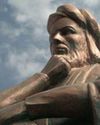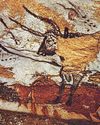
According to legend, the great sage Prince Shōtoku was able to speak as soon as he was born and was so wise when he grew up that he could attend to the suits of ten men at once and decide them all without error. He knew beforehand what was going to happen. He was the reincarnation of Queen Srimala and of the Indian monk Bodhidharma, and the manifestation of the Bodhisattva Guze Kannon. When the prince met a starving man on the side of the road, he provided him with food and water and also gave him his coat. The following day, he sent a messenger to check on the man, but he was already dead, so Shōtoku ordered that he be properly buried. Suspecting that he was in fact, a holy man, he sent someone to check on the tomb, who found that the corpse was gone and only the prince's coat remained. This the prince continued to wear, proving that both the starving man and the prince were holy men.
Such are the things that are said about Shōtoku. The hagiography about him is so thickly layered that it's difficult to reach historical reality. There was even a cult of the prince (taishi shinkō) that formed around the Middle Ages. Of course, he was a man like any other; but maybe a little wiser than the rest. In fact he was a statesman and something of a political philosopher, who would be immortalized as the father of the Japanese state, the father of Japanese Buddhism, and the father of Japanese philosophy.
Civil War in Sixth Century Japan
This story is from the October/November 2023 edition of Philosophy Now.
Start your 7-day Magzter GOLD free trial to access thousands of curated premium stories, and 9,000+ magazines and newspapers.
Already a subscriber ? Sign In
This story is from the October/November 2023 edition of Philosophy Now.
Start your 7-day Magzter GOLD free trial to access thousands of curated premium stories, and 9,000+ magazines and newspapers.
Already a subscriber? Sign In

Metaphors & Creativity
Ignacio Gonzalez-Martinez has a flash of inspiration about the role metaphors play in creative thought.

Medieval Islam & the Nature of God
Musa Mumtaz meditates on two maverick medieval Muslim metaphysicians.

Robert Stern
talks with AmirAli Maleki about philosophy in general, and Kant and Hegel in particular.

Volney (1757-1820)
John P. Irish travels the path of a revolutionary mind.

IT'S A WONDERFUL LIFE
Becky Lee Meadows considers questions of guilt, innocence, and despair in this classic Christmas movie.

"I refute it thus"
Raymond Tallis kicks immaterialism into touch.

Cave Girl Principles
Larry Chan takes us back to the dawn of thought.

A God of Limited Power
Philip Goff grasps hold of the problem of evil and comes up with a novel solution.

A Critique of Pure Atheism
Andrew Likoudis questions the basis of some popular atheist arguments.

Exploring Atheism
Amrit Pathak gives us a run-down of the foundations of modern atheism.